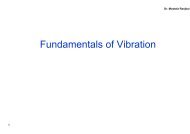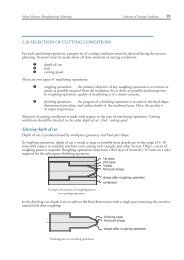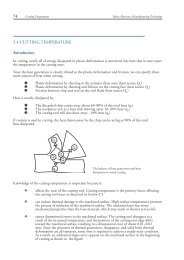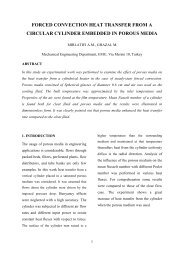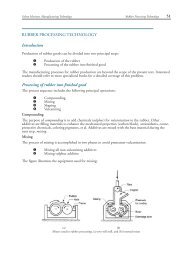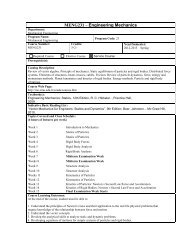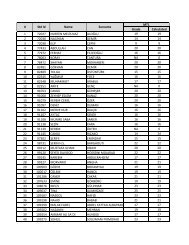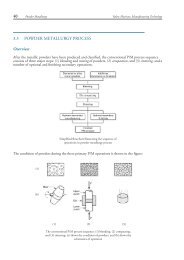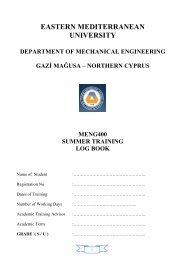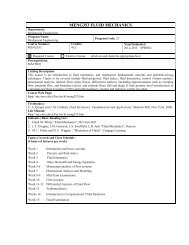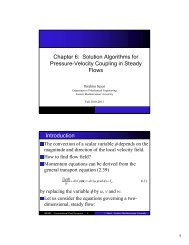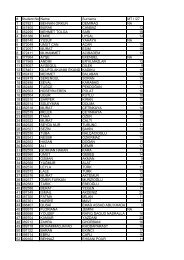SIMPLE Method on Non-staggered Grids - Department of ...
SIMPLE Method on Non-staggered Grids - Department of ...
SIMPLE Method on Non-staggered Grids - Department of ...
You also want an ePaper? Increase the reach of your titles
YUMPU automatically turns print PDFs into web optimized ePapers that Google loves.
<str<strong>on</strong>g>SIMPLE</str<strong>on</strong>g> METHOD FOR THE SOLUTION OF INCOMPRESSIBLE<br />
FLOWS ON NON-STAGGERED GRIDS<br />
I. Sezai - Eastern Mediterranean University, Mechanical Engineering <strong>Department</strong>, Mersin 10 -Turkey<br />
Revised in January, 2011<br />
1. Introducti<strong>on</strong><br />
There are usually two kinds <strong>of</strong> grid arrangements used to solve the fluid flow problems:<br />
<strong>staggered</strong> grids and n<strong>on</strong>-<strong>staggered</strong> grids. For the n<strong>on</strong><strong>staggered</strong> grids, vector variables and<br />
scalar variables are stored at the same locati<strong>on</strong>s, while for the <strong>staggered</strong> grids, vector<br />
comp<strong>on</strong>ents and scalar variables are stored at different locati<strong>on</strong>s, shifted half c<strong>on</strong>trol<br />
volume in each coordinate directi<strong>on</strong>. Staggered grids are popular because <strong>of</strong> their ability<br />
to prevent checkerboard pressure in the flow soluti<strong>on</strong> as discussed in Chapter 6.<br />
However, programming <strong>of</strong> the <strong>staggered</strong> grid method is tedious since u and v-momentum<br />
equati<strong>on</strong>s are discretized at different c<strong>on</strong>trol volumes shifted in different directi<strong>on</strong>s from<br />
the main c<strong>on</strong>trol volumes. The programming difficulties increase when <strong>on</strong>e deals with<br />
curvilinear or unstructured grids. As a result, nearly all codes written <strong>on</strong> curvilinear or<br />
unstructured grids use n<strong>on</strong>-<strong>staggered</strong> grid arrangement for the soluti<strong>on</strong> <strong>of</strong> fluid flow<br />
problems.<br />
On the other hand n<strong>on</strong>-<strong>staggered</strong> grids are pr<strong>on</strong>e to produce a false pressure field -<br />
checkerboard pressure if special precauti<strong>on</strong>s is not taken. For this reas<strong>on</strong>, in the early<br />
1980s and before, n<strong>on</strong>-<strong>staggered</strong> were rarely used for incompressible flow. However,<br />
since 1983 the n<strong>on</strong><strong>staggered</strong> grid (or collocated grid) has been used more widely, after<br />
Rhie and Chow (1983) proposed a momentum interpolati<strong>on</strong> method to eliminate the<br />
checkerboard pressure problem.<br />
1. Mathematical Formulati<strong>on</strong><br />
The governing equati<strong>on</strong>s for two dimensi<strong>on</strong>al incompressible laminar heat and fluid flow<br />
in Cartesian coordinates with c<strong>on</strong>stant properties are:<br />
c<strong>on</strong>tinuity equati<strong>on</strong><br />
1
∂ u<br />
∂ x<br />
+<br />
∂ v<br />
∂ y<br />
= 0<br />
(1)<br />
u-momentum equati<strong>on</strong><br />
( ρ ) ( ρ ) ( ρ )<br />
∂ u ∂ uu ∂ vu ∂p ∂ ⎛ ∂u⎞<br />
∂ u<br />
μ<br />
⎛ ∂<br />
+ + =− + ⎜ ⎟+ ⎜μ<br />
⎞<br />
⎟+<br />
s<br />
∂t ∂x ∂y ∂x ∂x⎝ ∂x⎠ ∂y⎝ ∂y<br />
⎠<br />
v-momentum equati<strong>on</strong><br />
( ρ ) ( ρ ) ( ρ )<br />
∂ v ∂ uv ∂ vv ∂p ∂ ⎛ ∂v⎞<br />
∂ v<br />
μ<br />
⎛ ∂<br />
+ + =− + ⎜ ⎟+ ⎜μ<br />
⎞<br />
⎟+<br />
s<br />
∂t ∂x ∂y ∂y ∂x⎝ ∂x⎠ ∂y⎝ ∂y⎠<br />
Energy equati<strong>on</strong><br />
( ) ( ) ( )<br />
∂ ρT ∂ ρuT ∂ ρvT ∂ ⎛ k ∂T ⎞ ∂ ⎛ k ∂T<br />
⎞<br />
+ + = + + s<br />
∂t ∂x ∂y ∂x⎜c ∂x ⎟ ∂y⎜c ∂y<br />
⎟<br />
⎝ p ⎠ ⎝ p ⎠<br />
Equati<strong>on</strong>s (2) – (4) can be expressed in a general form as:<br />
( ) ( u ) ( v )<br />
∂ ρφ ∂ ρ φ ∂ ρ φ ∂ ⎛ ∂φ ⎞ ∂ ⎛ ∂φ<br />
⎞<br />
+ + = ⎜Γ ⎟+ ⎜Γ ⎟+<br />
sφ<br />
∂t ∂x ∂y ∂x⎝ ∂x ⎠ ∂y⎝ ∂y<br />
(5)<br />
⎠<br />
where u and v are the velocity comp<strong>on</strong>ents, T is temperature and φ is any dependent<br />
variable (i.e. u, v and T), and t, ρ , Γ , and s φ<br />
are time, density, diffusi<strong>on</strong> coefficient, and<br />
source term per unit volume, respectively. Also,s u and s v terms represents source terms<br />
per unit mass, ie. drag forces, buyancy forces etc. Note that for the c<strong>on</strong>tinuity equati<strong>on</strong>,<br />
φ = 1, Γ= 0 , and s φ<br />
= 0 .<br />
In numerical calculati<strong>on</strong>s, the source terms in the above equati<strong>on</strong>s are written in<br />
linearized form as<br />
s = sc + spφ<br />
p<br />
For example, for natural c<strong>on</strong>vecti<strong>on</strong> problems, the right hand side <strong>of</strong> the v-momentum<br />
equati<strong>on</strong> c<strong>on</strong>tain an additi<strong>on</strong>al term ρ g <br />
− β ref<br />
( T − T ∞)<br />
, for which the source terms are<br />
<br />
sc<br />
=−ρrefgβ ( T −T∞<br />
) and s p = 0. Similarly, for problems involving heat generati<strong>on</strong> the<br />
right hand side <strong>of</strong> the energy equati<strong>on</strong> have an additi<strong>on</strong>al term q which is the energy<br />
generati<strong>on</strong> per unit volume. In this case, s c = q , s p = 0.<br />
T<br />
v<br />
u<br />
(2)<br />
(3)<br />
(4)<br />
2
The governing equati<strong>on</strong>s are discretized by using the finite-volume method <strong>on</strong> a<br />
n<strong>on</strong><strong>staggered</strong> grid system in which all variables are stored at the center <strong>of</strong> the c<strong>on</strong>trol<br />
volume (Figure 1).<br />
Integrating Eq. (5) over the c<strong>on</strong>trol volume with bounded cell faces e, w, n, and s<br />
surrounding center P, we have<br />
ρΔxΔy<br />
o<br />
( φP − φP) + ⎡( ρuφ) −( ρuφ) ⎤Δ y+ ⎡( ρvφ) −( ρvφ)<br />
⎤Δ x=<br />
e w n s<br />
Δt<br />
⎣ ⎦ ⎣ ⎦<br />
⎡ Γe Γ ⎤ ⎡<br />
w<br />
Γn Γ ⎤<br />
s<br />
( φE −φP) − ( φP −φW ) Δ y+ ( φN −φP) − ( φP −φS)<br />
Δx<br />
(6)<br />
⎢ ⎥ ⎢ ⎥<br />
⎣δ xe δ xw ⎦ ⎣δ yn δ ys<br />
⎦<br />
+ s ΔxΔ y+ s φ ΔxΔy<br />
c P P<br />
where the superscript o refers to the previous time level and Δ x , Δ y , δ x , δx , δy<br />
and<br />
δ y s<br />
are geometric lengths as shown in Figure 1.<br />
e w n<br />
Figure 1. N<strong>on</strong><strong>staggered</strong> Grid Arrangement<br />
The discretized c<strong>on</strong>tinuity equati<strong>on</strong> for incompressible flow is<br />
( ρue) Δy−( ρuw) Δ y+ ( ρvn) Δx−( ρvs) Δ x= 0<br />
(7)<br />
The cell face values φ e , φ w etc are calculated using QUICK or any other high order<br />
scheme in a deferred correcti<strong>on</strong> manner. Substituting these values into Eq. (6) and<br />
3
earranging, we obtain the final discretized equati<strong>on</strong> for any general variable φ as<br />
follows:<br />
o o<br />
aPφP = aEφE + aWφW + aNφN + aSφS + aPφP<br />
+ b+ pterm<br />
(8)<br />
where<br />
aE<br />
=<br />
ΓΔ<br />
e<br />
y<br />
+ max ⎡−( ρu ) Δy, 0⎤<br />
e<br />
Δx<br />
⎣<br />
⎦<br />
e<br />
aW<br />
=<br />
ΓΔ<br />
w<br />
y<br />
+ max ⎡( ρu)<br />
Δy, 0⎤<br />
w<br />
Δx<br />
⎣ ⎦<br />
w<br />
aN<br />
=<br />
ΓΔ<br />
n<br />
x<br />
+ max ⎡−( ρv)<br />
Δx<br />
, 0⎤<br />
n<br />
Δy<br />
⎣<br />
⎦<br />
n<br />
aS<br />
=<br />
ΓΔ<br />
s<br />
x<br />
+ max ⎡( ρv)<br />
Δx<br />
, 0⎤<br />
s<br />
Δy<br />
⎣<br />
⎦<br />
s<br />
o ρΔΔ<br />
x y<br />
aP<br />
=<br />
Δt<br />
o<br />
aP = aE + aW + aN + aS + aP − Sp<br />
+ΔF<br />
Δ F = ( ρu) Δy−( ρu) Δ y+ ( ρv) Δx−( ρv)<br />
Δx<br />
e w n s<br />
b= ( sc )<br />
eqn<br />
ΔxΔ y+ b1 b1<br />
= Sdc + ( Sc)<br />
bc<br />
Sp = ( sp) eqnΔxΔ y+<br />
( Sp)<br />
bc<br />
(9)<br />
Sdc = −max ⎡<br />
⎣( ρu) Δy, 0⎤( ) max ( ) , 0 ( )<br />
e ⎦ φe − φP + ⎡<br />
⎣<br />
− ρu Δy<br />
⎤<br />
e ⎦ φe −φE<br />
−max ⎡<br />
⎣<br />
−( ρu) Δy, 0⎤( w P) max ( ) , 0 ( w W)<br />
w ⎦ φ − φ + ⎡<br />
⎣ ρu Δy<br />
⎤<br />
w ⎦ φ −φ<br />
−max ⎡<br />
⎣( ρv) Δx , 0⎤( φn φP) max ( ρv) x, 0 ( φn φN)<br />
n ⎦<br />
− + ⎡<br />
⎣<br />
− Δ ⎤<br />
n ⎦<br />
−<br />
−max ⎡<br />
⎣<br />
−( ρv) Δx, 0⎤( φs − φP) + max ⎡( ρv) Δx, 0⎤( φs −φS)<br />
s ⎦ ⎣ s ⎦<br />
⎧=−( pe<br />
−pw) Δy<br />
for x-momentum equati<strong>on</strong><br />
⎪<br />
pterm= ⎨=−( pn<br />
− ps) Δx<br />
for y-momentum equati<strong>on</strong><br />
⎪<br />
⎩ = 0 for all other equati<strong>on</strong>s<br />
( s ) , ( s ) = source terms per unit volume in the differential equati<strong>on</strong> (buoyancy, drag for<br />
p eqn c eqn<br />
( Sp) bc, ( S<br />
c) bc=<br />
source c<strong>on</strong>tributi<strong>on</strong>s <strong>of</strong> near-boundary points<br />
where b represents all discretized source terms, excluding the pressure term. The term S dc<br />
is the source c<strong>on</strong>tributi<strong>on</strong>, which results from the adopti<strong>on</strong> <strong>of</strong> the deferred-correcti<strong>on</strong><br />
o<br />
procedure in which the face values <strong>of</strong> the independent variable, φ<br />
P<br />
is the value <strong>of</strong> φ<br />
P<br />
from the previous time step. φ e , φ w , φ n , φ s are calculated from a suitable high order<br />
4
scheme such as QUICK. The term S bc is the source c<strong>on</strong>tributi<strong>on</strong> <strong>of</strong> the near boundary<br />
points. For example, for a west boundary, if a Dirihlet boundary c<strong>on</strong>diti<strong>on</strong> φ = φ w exists,<br />
then, for a point near a west boundary, the source c<strong>on</strong>tributi<strong>on</strong> is S bc = a W φ w , where a W<br />
would be the coefficient if that point were an interior point. Similarly, (S p ) bc is the source<br />
c<strong>on</strong>tributi<strong>on</strong> <strong>of</strong> the near boundary points.<br />
Also, note that for source terms small letters corresp<strong>on</strong>d to per unit mass <strong>of</strong> the source.<br />
That is, S = sΔV, S c = s c ΔV, and S p = s p ΔV, where ΔV is the volume <strong>of</strong> the c<strong>on</strong>trol<br />
volume.<br />
It can be observed that the coefficients <strong>of</strong> the discretized x- and y-momentum equati<strong>on</strong>s<br />
are the same in collocated grid system (excluding the near boundary points), provided<br />
that the diffusi<strong>on</strong> coefficients Γ are the same in x and y-directi<strong>on</strong>s.<br />
In order to slow down the changes <strong>of</strong> dependent variables in c<strong>on</strong>secutive<br />
soluti<strong>on</strong>s, an underrelaxati<strong>on</strong> factor is introduced into the discretized equati<strong>on</strong> as follows:<br />
( 1−αφ<br />
)<br />
−1<br />
aP<br />
φ = a φ + a φ + a φ + a φ + a φ + b+ pterm+ a φ<br />
α<br />
(10)<br />
φ<br />
o o n<br />
P E E W W N N S S P P P P<br />
αφ<br />
where the superscript (n-1) refers to the previous iterati<strong>on</strong>. In that case, the terms in Eq.<br />
(9)are redefined as<br />
⎧ aP<br />
n 1<br />
b ← b + (1 −<br />
−<br />
α)<br />
φP<br />
⎪<br />
α<br />
⎨<br />
⎪ aP<br />
aP<br />
←<br />
⎪⎩ α<br />
Equati<strong>on</strong> (10) can be written as<br />
α<br />
α pterm<br />
1<br />
( a a a a b a<br />
o o ) ( 1 ) n φ<br />
φ = φ + φ + φ + φ + + φ + − αφ<br />
φ − + (11)<br />
a<br />
or<br />
φ<br />
P E E W W N N S S P P P P<br />
aP<br />
α<br />
αφpterm<br />
φ = ( a φ + a φ + a φ + a φ + B ) + (12)<br />
a<br />
φ<br />
P E E W W N N S S P<br />
aP<br />
where<br />
( 1−αφ<br />
)<br />
−1<br />
B = b + a φ + a φ<br />
(13)<br />
o o n<br />
P P P P P P<br />
αφ<br />
P<br />
P<br />
5
4. Momentum Interpolati<strong>on</strong><br />
4.1. Momentum interpolati<strong>on</strong> for steady-state problem<br />
BP = bP + ⎡⎣ 1−αu αu⎤⎦ aPuP<br />
[Eq.(13)]. For the<br />
n−1<br />
Note that for the steady problems ( )<br />
velocity comp<strong>on</strong>ent u at nodes P and E, Eq. (12) can be written as<br />
u<br />
u<br />
P<br />
E<br />
( )<br />
( a )<br />
P<br />
P<br />
( )<br />
( a )<br />
αu ∑<br />
i<br />
au<br />
i i<br />
+ Bp α<br />
P uΔy pe − pw<br />
P<br />
= − (14)<br />
( )<br />
( a )<br />
P<br />
E<br />
P<br />
P<br />
( )<br />
( a )<br />
αu ∑<br />
i<br />
au<br />
i i<br />
+ Bp α<br />
E uΔy pe − pw<br />
E<br />
= − (15)<br />
Mimicking the formulati<strong>on</strong> <strong>of</strong> u<br />
E<br />
interface velocity at the cell face e.<br />
u<br />
e<br />
( )<br />
( a )<br />
P<br />
e<br />
P<br />
E<br />
and u<br />
P<br />
, we can obtain the following expressi<strong>on</strong> for the<br />
( )<br />
( a )<br />
αu ∑<br />
i<br />
au<br />
i i<br />
+ Bp α<br />
e uΔy pE − pP<br />
= − (16)<br />
P<br />
e<br />
where the terms <strong>on</strong> the right-hand side with subscript e should be interpolated in an<br />
appropriate manner. The interface velocity at cell faces w, n, and s can be obtained<br />
similarly.<br />
In Rhie and Chow’s momentum interpolati<strong>on</strong>, the first term and 1 ( aP ) in sec<strong>on</strong>d<br />
e<br />
term <strong>of</strong> the Eq.(16) are linearly interpolated from their counterparts in Eqs.(14) and (15):<br />
⎛∑ au + B ⎞ ⎛∑ au + B ⎞ ⎛∑ au + B ⎞<br />
⎜ ⎟ ⎜ ⎟ ( 1 fe<br />
) ⎜ ⎟<br />
⎝ ⎠ ⎝ ⎠ ⎝ ⎠<br />
i i i p + i i i p + i i i p<br />
= fe<br />
+ −<br />
aP a<br />
e P<br />
a<br />
E P P<br />
(17)<br />
1 + 1 + 1<br />
= f + − (18)<br />
a a a<br />
e<br />
( ) ( )<br />
( 1 fe<br />
) ( )<br />
P e P E P P<br />
where f + e<br />
is a linear interpolati<strong>on</strong> factor defines as<br />
+ Δx<br />
P<br />
f<br />
e<br />
= (19)<br />
2δ x<br />
e<br />
In order to have a better understanding <strong>of</strong> Eq. (16), substituting ( au B a )<br />
Eq. (17) and ( ∑ au + B a ) , ( au B a )<br />
i i i p P P<br />
o o<br />
(16) and omitting the term au , we obtain<br />
P<br />
P<br />
i i i p P E<br />
∑ + from<br />
i i i p P e<br />
∑ + from Eqs. (14) and (15) into Eq.<br />
6
( − p ) +<br />
fe<br />
( aP)<br />
e<br />
α y( p p<br />
+<br />
)<br />
e<br />
( a )<br />
( − p )<br />
( a )<br />
⎧ αuΔy p<br />
αuΔy p<br />
E P e w<br />
⎫<br />
E<br />
⎪− +<br />
⎪<br />
+ + ⎪<br />
P E ⎪<br />
ue = ⎡fe uE ( 1 fe ) u ⎤<br />
⎣<br />
+ −<br />
P⎦ +⎨ ⎬<br />
⎪<br />
uΔ e<br />
−<br />
w P<br />
⎪<br />
⎪<br />
+ ( 1−<br />
f )<br />
⎪<br />
⎩<br />
P P<br />
⎭<br />
Equati<strong>on</strong>s (16) and (20) are essentially equivalent. However, Eq. (20) separates<br />
the interfacial velocity into two parts: a linear interpolati<strong>on</strong> part and the additi<strong>on</strong>al <strong>on</strong>e.<br />
The term in first set <strong>of</strong> brackets <strong>of</strong> Eq. (20) is the arithmetic-averaged values (linear<br />
interpolati<strong>on</strong> method) <strong>of</strong> two neighbor nodal velocities. The term in braces can be<br />
regarded as a correcti<strong>on</strong> term, which has the functi<strong>on</strong> <strong>of</strong> smoothing the pressure field, and<br />
it is this term that may remove the unrealistic pressure field.<br />
Equati<strong>on</strong>s (16) with (17) and (18) or equati<strong>on</strong> (20) c<strong>on</strong>stitute the Rhie and Chow’s<br />
Original Momentum Interpolati<strong>on</strong> <str<strong>on</strong>g>Method</str<strong>on</strong>g> (OMIM). Majumdar (1988) reported that<br />
soluti<strong>on</strong>s <strong>of</strong> steady-state problems from Rhie and Chow OMIM are dependent <strong>on</strong> the<br />
underrealxati<strong>on</strong> factor. To eliminate this underrelaxati<strong>on</strong> factor dependency, an iterati<strong>on</strong><br />
algorithm was proposed by him to calculate the cell-face velocity for steady-state<br />
problem as follows:<br />
( )<br />
( )<br />
( a )<br />
α ∑ au + b α Δy p − p<br />
u u f u f u<br />
( 1 α ) ⎡<br />
( 1 )<br />
u i i i p<br />
e u E P n− 1 + n− 1 + n−1<br />
e<br />
= − + −<br />
u e e E e P<br />
( aP)<br />
⎣<br />
+ − −<br />
e<br />
P e<br />
where superscript n-1 refer to previous iterati<strong>on</strong> values. This iterative implementati<strong>on</strong><br />
algorithm can achieve a unique soluti<strong>on</strong> that is independent <strong>of</strong> underrelaxati<strong>on</strong> factors.<br />
⎤<br />
⎦<br />
(20)<br />
(21)<br />
4.2. Momentum interpolati<strong>on</strong> for unsteady problems<br />
Choi (1999) reported that, the soluti<strong>on</strong> using the original Rhie and Chow scheme<br />
is time step size dependent. He proposed a modified Rhie and Chow scheme for an<br />
unsteady problem as follows, which is quite similar to Majumdar’s scheme for a steady<br />
problem:<br />
( )<br />
( )<br />
⎛∑ au + b ⎞ α Δy p − p α a<br />
u u u<br />
o<br />
i i i p u E P n−1<br />
u e o<br />
e<br />
= αu⎜<br />
⎟ − + ( 1− αu)<br />
e<br />
+<br />
e<br />
⎝ aP ⎠ aP ( aP)<br />
e e e<br />
with<br />
a<br />
o<br />
e<br />
ρδ xeΔy<br />
=<br />
Δt<br />
(22)<br />
(23)<br />
7
It is to be noted that body-force term is neglected for simplicity <strong>of</strong> presentati<strong>on</strong>. By a<br />
similar substituti<strong>on</strong> process as the <strong>on</strong>e for the Majumdar’s interpolati<strong>on</strong> in Eq. (21), the<br />
Eq. (22) can be written equivalently as<br />
( 1 )<br />
u ⎡f u f u ⎤<br />
⎣<br />
⎦<br />
( − p ) +<br />
fe<br />
( aP)<br />
e<br />
α Δy( p − p<br />
+<br />
)<br />
e<br />
( a )<br />
⎧ α Δy p<br />
⎪− +<br />
⎪<br />
⎪<br />
⎪+ ( 1−<br />
f )<br />
⎪<br />
( − p )<br />
( a )<br />
u E P u e w E<br />
u e w P<br />
α Δy p<br />
+ +<br />
P P<br />
e<br />
=<br />
e E<br />
+ −<br />
e P<br />
+⎨ ⎬<br />
n− 1 + n− 1 + n−1<br />
( 1 α ) ⎡<br />
u<br />
ue fe uE ( 1 fe ) u ⎤<br />
⎣<br />
P<br />
⎦<br />
o<br />
o<br />
⎡α<br />
α ( a )<br />
+ +<br />
⎢<br />
( 1 )<br />
⎪+ − + − −<br />
⎪<br />
⎪<br />
o<br />
a α ( a<br />
⎪ u f u f<br />
)<br />
+ − − −<br />
u<br />
⎪ ⎢( a ) a a<br />
⎩ ⎣<br />
u e o u P<br />
E o u P<br />
P o<br />
e e E e P<br />
P ( P)<br />
( P)<br />
e E P<br />
P<br />
E<br />
⎫<br />
⎪<br />
⎪<br />
⎪<br />
⎪<br />
⎪<br />
⎪<br />
⎪<br />
⎤⎪<br />
⎥⎪<br />
⎥⎪<br />
⎦⎭<br />
(24)<br />
According to Yu et al. (2002), soluti<strong>on</strong>s by using this scheme are still time step<br />
size dependent, though the dependence is quite small. They proposed a different<br />
interpolati<strong>on</strong> technique for the terms appearing in equati<strong>on</strong> (22) which appears to be both<br />
under relaxati<strong>on</strong> factor and time step size independent. In this method the first term <strong>on</strong><br />
the right-hand side <strong>of</strong> Eq. (22) is interpolated as follows:<br />
∑ au + b<br />
( ∑ +<br />
1) + ( 1− )( ∑ + )<br />
E<br />
1<br />
+ +<br />
fe ( sc) ( 1 fe )( sc)<br />
⎤δ<br />
x<br />
E<br />
P e<br />
y<br />
( ∑ ) + ( 1− )( ∑ )<br />
f au b f au b<br />
+ +<br />
e i i i e i i i<br />
+ ⎡ + − Δ<br />
⎛ i i i p ⎞ ⎣ ⎦<br />
⎜ ⎟ =<br />
+ +<br />
⎝ aP ⎠ f<br />
e e i<br />
ai f<br />
E e i<br />
ai<br />
P<br />
where b<br />
1<br />
is defined in Eq. (9).<br />
( ) ( 1 )( )<br />
− ⎡f s + − f s ⎤δ<br />
x Δ y+<br />
a<br />
⎣<br />
⎦<br />
+ +<br />
o<br />
e p<br />
E<br />
e p<br />
P<br />
e e<br />
Also, the denominator <strong>of</strong> the sec<strong>on</strong>d and third terms in Eq. (22) is interpolated as follows:<br />
+ +<br />
( a ) = f ( ∑ a ) + ( 1− f )( ∑ a )<br />
P e e i i E e i i P<br />
( ) ( 1 )( )<br />
− ⎡f s + − f s ⎤δ<br />
x Δ y+<br />
a<br />
⎣<br />
⎦<br />
+ +<br />
o<br />
e p<br />
E<br />
e p<br />
P<br />
e e<br />
Equati<strong>on</strong> (22) combined with Eq. (25) and Eq. (26) is Yu et al.’s (2002) new<br />
scheme. Substituting Eq. (25) into Eq. (22) the following equati<strong>on</strong> is obtained:<br />
P<br />
(25)<br />
(26)<br />
8
⎧ + +<br />
⎡fe ( aP) uE+ ( 1−<br />
fe )( aP)<br />
u ⎤<br />
P<br />
⎪⎣<br />
E<br />
P ⎦<br />
⎪ ⎡ + + +<br />
( fe ( sc) ( 1 fe )( sc)<br />
) δ xe y fe ( sc)<br />
x<br />
E P E E<br />
y⎤<br />
⎪<br />
+ − Δ − Δ Δ<br />
α ⎢<br />
⎥<br />
⎪+ u ⎢ +<br />
( 1 fe )( sc)<br />
x<br />
P P<br />
y<br />
⎥<br />
⎪ ⎣<br />
− − Δ Δ<br />
⎦<br />
1<br />
⎪<br />
u = ⎨+ α ⎡ y p p f y p p f y p p<br />
E<br />
( aP<br />
) ⎣<br />
−Δ − + Δ − + − Δ −<br />
e ⎪<br />
n− 1 + n− 1 + n−1<br />
⎪+ ( 1−αu) ⎡( aP) ue − fe ( aP) uE −( 1−<br />
fe )( aP)<br />
u ⎤<br />
e E P<br />
P<br />
⎪ ⎣<br />
⎦<br />
⎪ o o + o o + o<br />
+ α ⎡<br />
o<br />
u<br />
au<br />
e e<br />
− fe ( aP) uE −( 1−<br />
fe )( aP)<br />
u ⎤<br />
⎪ ⎣<br />
E<br />
P<br />
P⎦<br />
⎪<br />
⎩ ⎪<br />
+ +<br />
( ) ( ) ( 1 ) ( )<br />
e u E P e e w e e w<br />
where ( a )<br />
P<br />
e<br />
is found from equati<strong>on</strong> (26). It should be noted that the term in the<br />
parenthesis, which is multiplied by (1–α u ) is incorrect in the paper <strong>of</strong> Yu et al.’s (2002).<br />
It should also be noted that the cell face velocities found from the momentum<br />
interpolati<strong>on</strong> method are used to determine the mass fluxes across the cell faces.<br />
They should not be used for the cell face value <strong>of</strong> the independent variable φ in the<br />
deferred correcti<strong>on</strong> term b dc in eq. (9) in the case φ stands for u or v in the x- or y-<br />
momentum equati<strong>on</strong>s. The face values <strong>of</strong> the independent variable φ are calculated<br />
using a suitable c<strong>on</strong>vecti<strong>on</strong> scheme, such as UPWIND or QUICK.<br />
P<br />
⎫<br />
⎪<br />
⎪<br />
⎪<br />
⎪<br />
⎪<br />
⎤<br />
⎪<br />
⎦⎬<br />
⎪<br />
⎪<br />
⎪<br />
⎪<br />
⎪<br />
⎪<br />
⎪ ⎭<br />
(27)<br />
The <str<strong>on</strong>g>SIMPLE</str<strong>on</strong>g> Algorithm<br />
For a guessed pressure field p * the corresp<strong>on</strong>ding face velocity<br />
Eq. (22) as<br />
( )<br />
( )<br />
* * *<br />
o<br />
* u i i i p<br />
e u E P n−1<br />
u e o<br />
e ( 1 αu)<br />
e e<br />
( aP)<br />
( aP)<br />
( aP)<br />
e e e<br />
*<br />
u<br />
e<br />
can be written using<br />
au b y p p a<br />
u α ∑ + α Δ −<br />
= − + − u + α u<br />
(28)<br />
*<br />
A similar equati<strong>on</strong> can be written for the face velocity v<br />
n<br />
. Now we define the correcti<strong>on</strong><br />
p' as the difference between the correct pressure field p and the guessed pressure field p *<br />
so that<br />
*<br />
p = p + p′<br />
(29)<br />
Similarly we define velocity correcti<strong>on</strong>s u' and v' as<br />
u = u + u′<br />
(30)<br />
*<br />
e e e<br />
9
v = v + v′<br />
(31)<br />
*<br />
n n n<br />
Subtracting Eq. (28) from Eq. (22) gives<br />
e<br />
( ′ )<br />
( a )<br />
P<br />
e<br />
( − )<br />
( a )<br />
αu ∑<br />
i<br />
au<br />
i i<br />
+ bp α<br />
e uΔy p′ E<br />
p′<br />
P<br />
u′ = − (32)<br />
P<br />
e<br />
As an approximati<strong>on</strong>, in <str<strong>on</strong>g>SIMPLE</str<strong>on</strong>g> method the first term in the above equati<strong>on</strong> is neglected<br />
giving<br />
( )<br />
u′ = d p′ − p′<br />
(33)<br />
u<br />
e e P E<br />
where<br />
d<br />
α A<br />
= (34)<br />
u u e<br />
e<br />
( aP<br />
)<br />
e<br />
where A e = Δy is the area <strong>of</strong> the c<strong>on</strong>trol volume at the east face. Similarly,<br />
( )<br />
v′ = d p′ − p′<br />
(35)<br />
v<br />
n n P N<br />
where<br />
d<br />
α A<br />
= (36)<br />
v v n<br />
n<br />
( aP<br />
)<br />
n<br />
Then the corrected velocities become<br />
( ′ ′ )<br />
u = u + d p − p<br />
(37)<br />
* u<br />
e e e P E<br />
( ′ ′ )<br />
v = v + d p − p<br />
(38)<br />
* v<br />
n n n P N<br />
Substituting the corrected face velocities such as that given by Eq.s (37)and (38) into the<br />
discretized c<strong>on</strong>tinuity equati<strong>on</strong> (7) gives<br />
a p′ = a p′ + a p′ + a p′ + a p′<br />
+ b<br />
(39)<br />
P P W W E E S S N N<br />
where<br />
a = ( ρ Ad) a = ( ρAd) a = ( ρAd) a = ( ρAd)<br />
E e W w N n S s<br />
* * * *<br />
( ρ ) ( ρ ) ( ρ ) ( ρ )<br />
b= u A − u A + v A − u A<br />
w e s n<br />
After solving the p' field from Eq. (39) the face velocities are corrected using Eq.'s (37)<br />
and (38) and the pressure field is corrected by using<br />
= + α ′<br />
(41)<br />
*<br />
p p<br />
p<br />
p<br />
where α p is the pressure under-relaxati<strong>on</strong> factor which is chosen to be between 0 and 1.<br />
(40)<br />
10
Similarly the nodal velocities are corrected using<br />
( ′ ′)<br />
u = u + d p − p<br />
(42)<br />
* u<br />
P P P w e<br />
( ′ ′)<br />
v = v + d p − p<br />
(43)<br />
* v<br />
P P P s n<br />
where<br />
d<br />
u<br />
P<br />
αuAe v αvAn<br />
= and d = (44)<br />
P<br />
( a ) ( a )<br />
P<br />
P<br />
P<br />
P<br />
The pressure correcti<strong>on</strong>s at the cell faces in Eqs. (42) and (43) are calculated by linear<br />
interpolati<strong>on</strong> from the nodal values as<br />
+ +<br />
p′ = f p′ + (1 − f ) p′<br />
(45)<br />
w w P w W<br />
+ +<br />
p′ = f p′ + (1 − f ) p′<br />
(46)<br />
e e E e P<br />
+ +<br />
p′ = f p′ + (1 − f ) p′<br />
(47)<br />
s s P s S<br />
+ +<br />
p′ = f p′ + (1 − f ) p′<br />
(48)<br />
n n N n P<br />
Boundary C<strong>on</strong>diti<strong>on</strong>s for Pressure<br />
Since there is no equati<strong>on</strong> for the pressure, no boundary c<strong>on</strong>diti<strong>on</strong>s are needed for the<br />
pressure at the boundary points. The pressure values at the boundary points can be<br />
calculated by linear extrapolati<strong>on</strong> using the two near-boundary node pressures.<br />
Boundary C<strong>on</strong>diti<strong>on</strong>s for Pressure Correcti<strong>on</strong> Equati<strong>on</strong><br />
When the velocities at the boundaries are known, there is no need to correct the velocities<br />
at the boundaries in the derivati<strong>on</strong> <strong>of</strong> the pressure correcti<strong>on</strong> equati<strong>on</strong>. For example if the<br />
velocity at the west boundary is known then for a c<strong>on</strong>trol volume near the west boundary:<br />
( ′ ′ )<br />
u = u + d p − p<br />
(49)<br />
u<br />
* u<br />
e e e P E<br />
w<br />
= u<br />
(50)<br />
wall<br />
( ′ ′ )<br />
v = v + d p − p<br />
(51)<br />
* v<br />
n n n P N<br />
( ′ ′ )<br />
v = v + d p − p<br />
(52)<br />
* v<br />
s s s S P<br />
Substituting equati<strong>on</strong>s (49)-(52) into the discretized c<strong>on</strong>tinuity equati<strong>on</strong> (7) we obtain the<br />
following pressure correcti<strong>on</strong> equati<strong>on</strong> for a c<strong>on</strong>trol volume near the west boundary<br />
a p′ = a p′ + a p′ + a p′ + a p′<br />
+ b<br />
(53)<br />
P P W W E E S S N N<br />
11
where<br />
a = ( ρ Ad) a = 0 a = ( ρAd) a = ( ρAd)<br />
a = a + a + a + a<br />
E e W N n S s<br />
P W E S N<br />
* * *<br />
( ρ ) ( ρ ) ( ρ ) ( ρ )<br />
b= uA − u A + v A − u A<br />
wall e s n<br />
Comparing Eq.'s (53)-(54) with (39)-(40) for a near boundary c<strong>on</strong>trol volume the same<br />
definiti<strong>on</strong> <strong>of</strong> the coefficients as used for the interior points can be used for a near<br />
boundary c<strong>on</strong>trol volume by setting the corresp<strong>on</strong>ding coefficient (a w in this case) to zero<br />
and using u wall in the b term.<br />
The above formulati<strong>on</strong> corresp<strong>on</strong>ds to Neumann boundary c<strong>on</strong>diti<strong>on</strong> ∂p´/∂n = 0, where n<br />
is normal to the boundary. As a result no value <strong>of</strong> pressure correcti<strong>on</strong> at the boundary<br />
( p′<br />
w<br />
) is involved in this formulati<strong>on</strong>. However, the value <strong>of</strong> the pressure correcti<strong>on</strong> is<br />
needed for correcting the nodal velocities near boundaries. For example, for correcting<br />
the u-velocity at a nodal point P near a west boundary, p′<br />
w<br />
at the west boundary is needed<br />
in accordance with equati<strong>on</strong> (42). This value can be obtained by using ∂p´/∂n = 0 at the<br />
boundary, that is using p′ (1, j) = p′<br />
(2, j)<br />
.<br />
References<br />
Choi S. K., "Note <strong>on</strong> the Use <strong>of</strong> Momentum Interpolati<strong>on</strong> <str<strong>on</strong>g>Method</str<strong>on</strong>g> for Unsteady Flows",<br />
Numerical. Heat Transfer Part, A, vol. 36, pp. 545-550, 1999.<br />
Majumdar S., "Role <strong>of</strong> Underrelaxati<strong>on</strong> in Momentum Interpolati<strong>on</strong> for Calculati<strong>on</strong> <strong>of</strong><br />
Flow with N<strong>on</strong><strong>staggered</strong> <strong>Grids</strong>", Numerical Heat Transfer, Part B, vol. 13, pp. 125-132,<br />
1988.<br />
Rhie C. M. and Chow W. L., "Numerical Study <strong>of</strong> the Turbulent Flow Past an Airfoil<br />
with Trailing Edge Separati<strong>on</strong>", AIAA Journal, vol. 21, no 11, pp. 1525-1535, 1983.<br />
Yu B., Tao W., and Wei J., "Discussi<strong>on</strong> <strong>on</strong> Momentum Interpolati<strong>on</strong> <str<strong>on</strong>g>Method</str<strong>on</strong>g> for<br />
Collocated <strong>Grids</strong> <strong>of</strong> Incompressible Flow", Numerical. Heat Transfer Part B, vol. 42, pp.<br />
141-166, 2002.<br />
(54)<br />
12




